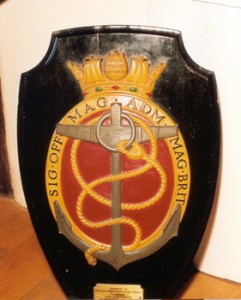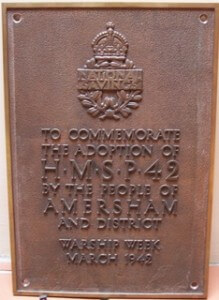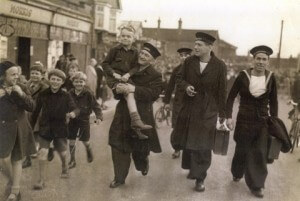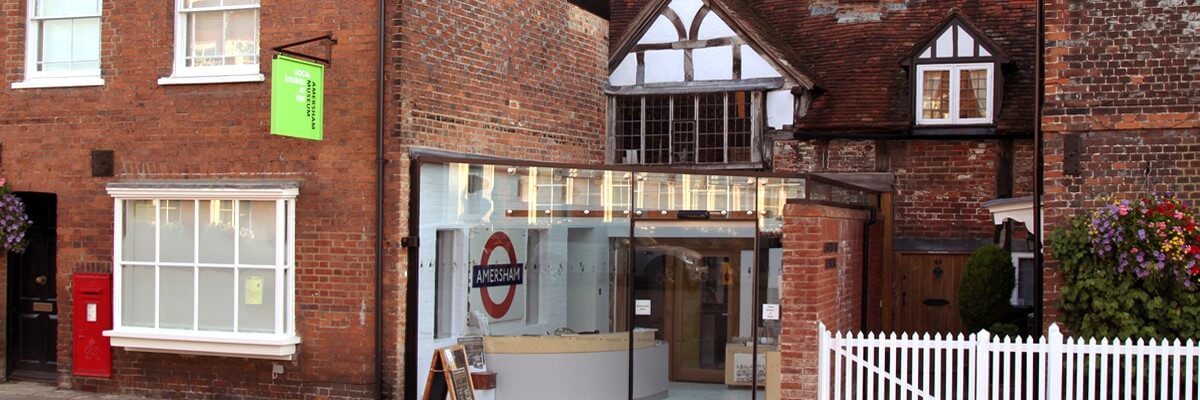This article was written by George Worrall for the Amersham Society/Amersham Museum newsletter and is reproduced here with permission.
 Among the many artefacts held by the Amersham Museum are two commemorative items that relate to the same event that occurred over 65 years ago. One is a large wooden shield which bears the badge of the Admiralty, below which is a small brass plate with the impressive legend “ Presented by the Lord Commissioners of the Admiralty to Amersham Rural District Council to commemorate the adoption of HMS P42 during Warship Week March 1942”.
Among the many artefacts held by the Amersham Museum are two commemorative items that relate to the same event that occurred over 65 years ago. One is a large wooden shield which bears the badge of the Admiralty, below which is a small brass plate with the impressive legend “ Presented by the Lord Commissioners of the Admiralty to Amersham Rural District Council to commemorate the adoption of HMS P42 during Warship Week March 1942”.  The other is a sizeable brass plate on which there is an embossed wreath-shaped crest centred with the words “National Savings” below which are the words: “To commemorate the adoption of H.M.S P.42 by the people of Amersham and District. Warship Week March 1942.” Neither object shows signs of weathering, consequently the most likely location where they were at one time on display was probably inside Elmodesham House during the period when the Town and Rural District Council had offices there.
The other is a sizeable brass plate on which there is an embossed wreath-shaped crest centred with the words “National Savings” below which are the words: “To commemorate the adoption of H.M.S P.42 by the people of Amersham and District. Warship Week March 1942.” Neither object shows signs of weathering, consequently the most likely location where they were at one time on display was probably inside Elmodesham House during the period when the Town and Rural District Council had offices there.
Most, but not necessarily all, readers will be familiar with the National Savings campaign during WWII. It was a scheme which had its debut during the first world war when the government needed to both reduce borrowing and to raise funds for the war effort, consequently the National Savings Movement was established in 1916 to encourage the British people to ‘save and prosper’; it has persisted in one form or another since then right up to the present day.
In November 1939, to support our costs in the Second World War (1939-1945), the War Savings Campaign was set up by the War Office and Regional Savings Committees were reorganised. In the 1940s even young children would have been very aware of the great publicity given to the campaign in which the population as a whole was encouraged to lend money to pay for the war effort. The National Savings Movement grew from volunteers who were organised into Local Savings Committees, which in turn, were supported by national committees and civil servants. Savings products were sold directly to the public and the funds were sent to the government. The range of products included, savings stamps, certificates, and bonds, which were provided not only by the Post Office Savings Bank, but also by other banks and financial institutions, such as building societies. In those early days small denomination savings stamps of as low as 6d. (2½p) were sold which, when enough stamps had been saved up, could be converted into low interest earning Savings Certificates.
The Movement simply named ‘National Savings’ was in effect a large scale scheme to promote saving in all its forms and the local volunteers were recognised for their dedication by the issuing of ‘long service awards’. Savings groups were formed in factories, shops, clubs, and so forth and an appointed collector did the rounds each week to collect the savings and issue certificates. My own mother operated a modest little group in south Manchester which she enthusiastically labelled the “Monty” Savings Group which, as all readers over 50, say, will surely know was the nickname of one of our most charismatic, and indeed successful Generals of WW II.
But war savings were not only limited to the purchase of certificates and bonds, local collections were also used to raise money for aeroplanes, tanks and any items which were urgently needed for the war effort. Slogans appeared such as “More Ships-Come on”, “War Savings are Warships”, “Warship Week – A Message From The Prime Minister”. A Naval Historical Branch document tells us that Warship Weeks were organised by the National Savings Committee, with the support of the Admiralty, and were intended to stimulate public loan investment by setting savings targets appropriate to the size of the community. These targets were matched with the sizes of vessels in the R.N. For Amersham and similar sized communities the figure was £500,000; this equated with a submarine. 25 submarines in all were thus adopted of which Amersham appears to have been the fourth in the sequence. The only other neighbouring community involved, at least as far as submarine adoption was concerned, and seventh in the sequence, was Berkhamsted had P44. Amersham’s submarine “Unbroken” was first registered as P42.
Item 46 of the Minutes of a meeting of Amersham Rural District Council held at the Board Room, Amersham on Tuesday 21st September 1943 reads as follows: -“46. NATIONAL SAVINGS COMMITTEE – H.M.S. “UNBROKEN”. The Clerk read a letter received from the Hon Secretary of the Local Savings Committee asking if the Council wished for representatives to serve with members of the Local Savings Committee on a Sub-Committee to be set up to consider the question of the adoption of the crew of HMS “Unbroken” and it was RESOLVED that Councillors HK Scott, AM Davies, H Jacobs, N Thomson and Captain MR Bouquet represent the Council on this Committee.”
Despite searches, the proceedings of the Savings Committee of that time have not come to light in public archives and I was informed that there is no correspondence pertaining to the submarine held by the town museum. Therefore we may never know why a vessel of the R.N. was what the town elected to adopt rather than a weapon or unit of one of the other two Services; there would perhaps have been more logic to have bid for a machine associated with either land or air warfare. Perhaps it was simply what was on offer at the time or the influence of a townsperson who had RN connections, but although one former Rector of Amersham, not too distant in time, had indeed served as a Chaplain in the RNVR from 1939-46, the Reverend Allan Campbell MA did not take up the incumbency until 1963, twenty years after the event, but whatever the reason it was an exciting and patriotic step.
But it is also unclear why the plaques record an event which took place some eighteen months before the meeting which, according to the minutes, was convened to approve it. A likely explanation is that Amersham and District had pledged itself during the publicised Warship Week of March 1942 to save sufficient to claim a submarine for adoption and that the required target sum was achieved later in the following year. Either that or the minutes should have recorded that the Sub-committee was intended simply to conclude arrangements for the visit of the already adopted crew to the town; or perhaps it was even the case that the vessel was adopted at an earlier date than that of the crew. We are not dealing with mind-bending research, however, so it is safe to conjecture that the chronology puts the first event, the Warship Week, well before the second event, the achievement of the savings target, before the third event, the adoption of the submarine, before the visit of the then crew of “HMS Unbroken” to Amersham during a brief period of leave or a crew change, and that this sequence started in March 1942 and concluded in October 1943. The dates on both plaques confirm the first date whilst Navy records confirm that there is no error in the second. The C.O. of Unbroken who was with the crewmen who visited Amersham was with the vessel from April 1943 to January 1944 only. We also know that during the visit the C.O. presented a plaque to the town, which may have been the one endorsed by the Lord Commissioners of the Admiralty. The town gave a plaque to the crew but if this has survived, its whereabouts are unknown.
In any event the dedicated Sub-Committee did not hang about, for in October 1943, only a week or two after its inaugural meeting, some 20 submariners, being most of the crew of H.M.S. Unbroken, came to Amersham by invitation to acknowledge and formalise the town’s adoption of their vessel and its crew. They arrived on a Friday afternoon and left on Sunday morning. There is enough surviving evidence of their sojourn to know that they had a right jolly old knees-up indeed. We even know that the celebratory menu consisted of soup, pork chops, two vegetables, and beer! It reminds many of us of the realities of wartime rationing.
The Amersham Museum’s database includes several photographs of the joyful weekend activities and one of the submarine itself “sailing into Portsmouth harbour”. One photograph, showing 17 members of the crew displaying their Jolly Roger flag, is annotated as ‘probably taken in Portsmouth’ but I think that it too, like the others, was taken in Amersham. For one thing the Lieutenant in the picture, who is undoubtedly the boat’s skipper at the time, Lt Bevis Andrew DSC, is wearing a wing collar and black bow tie, just as he is in at least one other photograph taken during the visit to Amersham. But it has to be said that in the book “Unbroken”, of which more is written below, and writing of another occasion at a dock, Andrew is recorded as being “resplendent, as ever, in a wing collar”. Whereas such apparel was recognised as appropriate wear for officers at formal evening functions, it seems that for Lt Andrew it was a personalised idiosyncrasy.
Other crew members are recognisable as being among the visiting contingent pictured in other shots. Furthermore off to the left of shot stands a cheerful line-up of what seem to be members of the Home Guard. Elsewhere in the background there is at least one lady, possibly Mrs Andrew (see text below). It seems unlikely that these non-RN personnel would pose alongside a photograph of crewmen in Portsmouth. They were undoubtedly part of the Amersham welcoming assembly. The texts and the photograph captions in two articles which covered the event, taken from the magazine “Illustrated” of October 30, 1943 and a contemporaneous copy of “Good Morning (Issue 195)”, a paper produced for the Submarine service by the Daily Mirror, are rich in some of the detail which might be of interest to those readers who, at whatever age, were living in and around Amersham in the early 1940’s or who heard about it from other sources. Perhaps some of the names ring bells and jog memories. I wonder if pen-friendships were struck up with any of the crew. Did any of them ever return to Amersham, one wonders?
The names of crew and their other detail mentioned in the articles were Lt Bevis Andrew DSC (+ Mrs Andrew)*, First Lieutenant Archdale (Number One)*, CPO Joe Sizer DSM*, Chief ERA L Manuel DSM (Ireland), AB James Bromhall DSM (Sheffield), Leading Stoker Charles Fall DSM (Essex)*, AB Arthur Burgess (Northampton), Stoker Albert Gurr (Bognor Regis), Ebenezer Lancelot, Peter Monkhouse, Leading Telegrapher J Crutch, Leading Telegrapher G F Cryer DSM*, Leading Stoker Geoffrey McTear, AB Jim Mullet, Sg William Osborne. [* Indicates among the names mentioned in Alastair Mars book “Unbroken” (see below) and who must therefore have been with the submarine since early 1942.]
Five of the Company had received awards by the date of the visit to Amersham. The townsfolk mentioned were Mr Alfred Woodley JP (Chairman of Amersham Council), Mr and Mrs Fennimore, Mr and Mrs Gibson, Miss Bowmaker, Barbara Wright 14, Christine Duncan 17.
Some of the photographs in the museum’s collection show the sailors with some of the other unidentified townsfolk and children. Various places are mentioned, including Amersham Station, a bowling green, Amersham Grammar School, The Mill Stream on Chequers Hill, The British Restaurant, a canteen with two billiards tables. Organisations mentioned are Amersham Girls’ Training Corps, Amersham Air Training Corps, prominent tradesmen, Civil Defence, the Home Guard.
 One museum photograph shows a shop called “Morris” in the background; another shows the crew waving down from a small beamed gallery in what may be part of what is now Ambers ladies’ fashion shop which, though originally a mill associated with lace work, was indeed a restaurant (The Mill Stream) at a later date.
One museum photograph shows a shop called “Morris” in the background; another shows the crew waving down from a small beamed gallery in what may be part of what is now Ambers ladies’ fashion shop which, though originally a mill associated with lace work, was indeed a restaurant (The Mill Stream) at a later date.
By the time Amersham became its adoptive community “Unbroken” had already achieved quite a reputation, mainly for operations in the hostile waters of the Mediterranean, having claimed four sinkings of which three were later confirmed. From offshore it had also shelled to destruction a train in Sicily. It was elsewhere recorded as having hit two enemy (Italian) cruisers in one salvo of four torpedoes putting both ships out of action for the remainder of the war; it subsequently survived 100 depth charges launched by pursuing Italian destroyers. The markings on its Jolly Roger, which seems to have been on prominent display throughout the crew visit to Amersham, tell us that from time to time it was also involved in clandestine operations. These might, for example, have included putting our agents or raiding parties ashore in enemy held territory. “The Fighting 42”, as it was then known, had by that time achieved the dubious distinction of being regarded as the most depth-charged submarine in our fleet. But it survived the war, only to be scrapped on the Tyne on 9 May 1950.
Because Lieutenant Commander Alastair Mars, DSO DSC and Bar, wrote a widely read book about his time aboard the vessel as its first Commanding Officer, still then but a Lieutenant, and entitled simply “Unbroken”, his name has become inextricably linked with the Amersham adoption. Some time ago I read the book before starting my research and was disappointed to find no mention of Amersham. The explanation was simple – by the time the adoption process was completed he was no longer C.O. Indeed by its apparent adoption date the vessel was then under the command of its third skipper, Lt. B. Andrew DSC, aged just 24. One still marvels at the rank and age of these young men who had command of a such an awesome vessel and who along with their fellow submariner crewmen faced the terrifying risks and dangers to which it was subject. With its crew of 3 other officers and 29 ratings, H.M.S Unbroken carried 8 torpedoes and was fitted with one 3-inch gun, which was capable of firing a 17.5lb; shell to a range of 12,000 yards, and three machine guns. The vessel had a range of 4050 miles at 10 knots while surfaced. It was launched in November 1941 and commissioned in January 1942.
Alastair Mars was with the submarine from 18 November 1941 until May 1942 only. As mentioned already, the formal adoption probably came somewhat later. But even if I have got the chronology about the adoption date wrong it does seem most unlikely that within two months of relinquishing his command of the vessel, and at a time when he was probably about to come off patrol in the hostile waters of the Mediterranean, that the Admiralty would be eager in its haste to break radio silence and tell him that he and his crew had just been adopted by a little town which he had probably never heard of. Nevertheless he was a controversial figure and in order to set the record aright I should perhaps afford him more space than his unsubstantiated connexion with Amersham perhaps deserves. From his writings one can readily detect that Alastair Mars was quite a tough, authoritarian, self-opinionated and resolute man, a bit of a rebel – brave, certainly, as indeed were all who faced the perils of sea warfare – all qualities which mark out the successful warrior one all too often needs. He was to become incensed by the exclusion of British naval forces from areas of the south Pacific which were the preserve of US naval forces. He felt that HM ships could have given the Japanese navy a better pasting. One can imagine his eagerness to defy authority. Later he flatly refused to accept a desk job rather than a shipboard post and declined an opportunity to resign. The Navy charged him with refusing to obey a lawful order. He faced out the challenge of a court martial and paid significant sums for his own defence. He lost. He then left the navy. One of his other books “Court Martial” tells the full story from his side but which I only paraphrase here. Anyway, interesting though his stories are, the likely chronology of events suggests that he might not even have known that his first command – HMS Unbroken – was later to be adopted by Amersham town. Last summer and quite by chance I met a man at a social event who did voluntary work at the RN Museum and who had at some time in his past come across Mars. He thought the former submariner might still be alive. In some cases, links between communities and their adopted vessels and past or present crew members have continued right up to the present day. But in Amersham’s case the only known continuing link with the nation’s seafaring guardians is through significant local involvement in support for the Lifeboat Service. When, in early 2005, the 60th anniversary of the end of World War II drew nigh, if you will pardon the pun, I floated the idea of inviting back to Amersham any of the surviving crew of Unbroken for a reunion event. I put it to the Town Council. They considered that it was a British Legion matter, not theirs. Unfortunately I had not researched the subject very thoroughly by then otherwise I might have persisted; as it was I decided not to press the point. I end by recording my thanks for help and advice given by the Library of the Royal Naval Museum, the archivist of The Royal Navy Submarine Museum, the archivists and librarians of the Centre for Buckinghamshire Studies, and the curator of the Amersham Museum.
These notes have been provided by Peter Schofield MA in 2013
There were 90 submarines adopted in total. Amersham was a late week as the last Warship Weeks in England and Wales were held between 21st and 28th March 1942. There were 30 U Class submarines adopted including HMS Unbroken. In Buckinghamshire the only other submarine was HMS Trusty adopted by Aylesbury.
The reason a submarine was adopted was firstly it was a themed campaign to increase National Savings and secondly the cost of a submarine would have been estimated by the Local Savings Committee as being affordable, based on the previous savings campaign of War Weapons Weeks. Other campaigns followed ‘Tanks for Attack, ‘Wings for Victory’ and ‘Salute the Soldier; for the latter two standard Bakelite plaques were presented. In War Weapons Week held in 1941 Amersham would have adopted a weapon of war which could have been an aircraft, ship or tank.
The metal plate I believe would have been presented to the submarine from the people of Amersham, it takes the same design as recommended by the National Savings Committee and also is made of a material suitable for the rigours and atmosphere on board a submarine of the period. On the other hand I would say it in such good condition because it was kept out of the sea-laden atmosphere of the upper deck. The plaque was probably returned to the town before Unbroken was transferred to the Russian Navy in June 1944.
The adoption plaque is of an Admiralty Shield because P42 in 1942 did not have an official crest or a name; eventually she was the first to carry the name Unbroken. Oddly an official crest was approved in December 1944, by which time she was serving with the Russian Navy.
Another article was in the Amersham Society Newsletter of April 1985, author unknown
The Society has recently been presented with a plaque which commemorates the adoption by the Town in War Weapons Week 1942 of the submarine P42. The submarine had an exciting history. She was a 600 ton vessel of the ‘U’ class. Built at Vickers Yard at Barrow in 1942 she was commissioned as HMS ‘Unbroken’. With an armament of four torpedo tubes, a 3” gun and two Vickers machine guns, she carried a crew of 32.
After her trials she went to the Mediterranean in February 1943. Operating mainly from Malta, she played no small part in the relief of that island and in the disruption of enemy communications which contributed to the final triumph of the Eighth Army in North Africa. In all, she was responsible for sinking more than 30,000 tons of enemy shipping and she so seriously damaged two Italian cruisers that they played no further part in the war. She also bombarded enemy coastal railways, destroying rolling stock and track, and took part in Commando-style operations. She was often attacked and had some very narrow escapes. Her Captain (Lieut. Alastair Mars) calculated that she withstood some 400 depth charges! With typical British understatement he described her record as ‘not bad’. What Higher Authority thought was shown by the award to him successively of the DSO and the DSC. There were numerous awards to other members of the crew.
‘Unbroken’ returned to this country in August 1944 and was loaned to the Russians in that year. Returned by them in 1949 she finished her career in the breaker’s yard at Newcastle in 1950. The full story is told in Lieut. Mars’ book ‘Unbroken’ which was first published in 1953. A popular work it rapidly ran through nine impressions.

